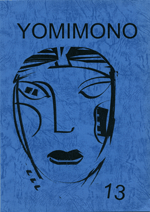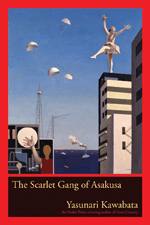Minor Press 小出版
Yomimono
|
Yomimono (“reading material”) is a small English-language journal with a literary bent published “once or twice a year” by author/editor Suzanne Kamata in Tokushima prefecture. It contains a good balance of quality prose and poetry with the occasional interview, essay and review. The contributors are international but not necessarily Japan based, which is a refreshing change from the heavily concentrated expat writing typical of English-language journals in Japan. As such Yomimono is global in scope, but still maintains a partiality to Japan, especially the prose. The design is simple and straightforward. The cover features a faux-primitive print on single-color, textured paper, while the contents are black and white, with the occasional image. At B5-size (the same as Koe) and 60 pages, give or take, it makes for a long, stimulating read. Yomimono is 1000 yen (or US$10) per issue and can be paid via Paypal to the editor, Suzanne Kamata, at: suekamata@msn.com. |
 「読物」は徳島県在住のスザンヌ蒲田さんが執筆/編集を行ない、年に1~2回のペースで発行される英語の雑誌。質の高い韻文にバランスよく詩が織り込まれ、インタビュー記事やエッセイ、レビューなども入る。以前は日本在住の外国人による英語雑誌の典型的な例だったが、今では寄稿者は日本在住者に限定していない。「読物」はグローバルな雑誌だが、散文で書かれた記事など日本的な部分も残っている。 デザインはすっきりしたもの。表紙は粗めの紙質で単色印刷、荒削りな印象だが、中身はモノクロながらところどころに写真も入る。B-5サイズ(「声」と同サイズ)で大体60ページくらいで読み応えのある内容。 「読物」は一冊1000円(10米ドル)で、スザンヌ蒲田さんあてのペイパルによる支払いも可能。suekamata@msn.com. |
Borderless Reading ボーダレス読物
The Scarlet Gang of Asakusa
|
Kawabata Yasunari’s The Scarlet Gang of Asakusa (Asakusa kurenaidan) is perhaps his most unorthodox and challenging novel, and that among a life’s body of work generally marked by experimental writing and diverse styles. The term “novel” may not even accurately capture this mesmerizing vortex of word and perception he wrote early in his career, some decades before he won the Nobel Prize. Originally serialized in a Tokyo daily newspaper between 1929 and 1930, it captures the zeitgeist of 1930s Asakusa by recording the observations of a wandering narrator. The point of view, however, shifts at some points, blurring who is actually doing the observing. A group of delinquents, most of them female, act as the narrator’s guide, revealing their way of life in this vibrant hub of pre-war Tokyo. The narrative is fractured and fragmentary, with Kawabata even stealing text and snippets from other printed matter of the time. In the end, it almost begins to seem as if Akasaka itself is speaking. Alisa Freedman’s recent English translation is thankfully available in annotated edition with original illustrations by Ota Saburô. |
 川端康成の小説「浅草紅団」は彼の一連の作品群の中で最も例外的かつ実験的な作品だろう。ノーベル文学賞を受賞する何十年も前という初期に書かれたこの作品は「小説」という言葉がしっくりこないような印象さえ受ける。 元々は昭和4年から5年にかけて東京朝日新聞に連載されたもので、さすらいの語り手が観察したものを記録する形で当時の浅草の時代精神を描いている。しかし途中で語り手の視点が変わっていくので、誰が本当の観察者なのかが分からなくなってくる。紅団というのは不良の集まりで、特に不良少女のグループのこと。この不良少女たちが語り手の案内役となり、活気に溢れていた戦前の浅草での彼女たちの生活が描かれる。川端は当時発行されていた他の印刷物から文章を拝借しているため、物語が途切れ途切れの感があり、終盤ではまるで浅草自体が喋っているかのような文章になっている。 |








